The growing threat of cyber-attacks underscores the necessity of effective cybersecurity training in businesses. Traditional methods like PowerPoint presentations and quizzes often fall short in terms of engaging employees and fostering long-term behavioral changes. Effective training is essential for preparing a workforce to navigate the complex landscape of cyber threats actively and instinctively.
Understanding Human Factors in Cybersecurity
The Psychological Exploit
Cybercriminals frequently target human psychology rather than technical vulnerabilities in their attacks. This orchestrated manipulation involves tactics such as creating a sense of urgency, leveraging perceived authority, and exploiting trust. Employees must be trained to recognize these manipulative techniques and react appropriately. Training programs should emphasize the psychological elements of cyber-attacks, enabling employees to remain vigilant in high-pressure situations. Awareness of tactics used by cybercriminals—such as sending urgent emails supposedly from a CEO—can make a significant difference in protecting an organization.
By dissecting and understanding the ways cybercriminals exploit human tendencies, employees can become more adept at identifying red flags in communications and transactions. For example, they should be trained to question uncharacteristic requests for sensitive information or urgent financial transfers. Additionally, training should focus on building skepticism and encouraging employees to verify requests through secondary channels. By honing skills in detecting psychological manipulation, employees can bolster their defenses against potential fraud and other cyber threats.
Real-world Examples
Real-world examples like phishing scams can effectively illustrate the deceptive nature of cyber-attacks. Narrative-driven training, which includes stories of employees falling victim to these scams, can create a lasting impact by contextualizing threats in a relatable manner. Stories serve as a powerful tool for embedding security principles deep into the mindset of employees. For instance, an employee who falls for a phishing email requesting urgent payment only to realize it was a scam can significantly underscore the risk and preventative measures.
Such illustrative anecdotes resonate more than abstract theoretical scenarios. These examples can also teach critical lessons on the common mistakes made and how employees can avoid them. Additionally, real-world stories underscore the importance of skepticism and verification in daily practices. Employees are more likely to remember and apply lessons learned from such realistic scenarios, thereby enhancing their preparedness for potential cyber threats.
Moving Beyond Traditional Training Methods
The Limits of Conventional Approaches
Traditional training approaches such as PowerPoint presentations and quizzes often fail to engage employees effectively. These methods can be dry and uninspiring, leading to rapid forgetting and disengagement. Employees are disconnected from the actual threat landscape, and such conventional tactics rarely instill the practical skills required to manage real-world scenarios. The format of traditional training seldom encourages active participation or critical thinking, resulting in knowledge that is quickly lost and rarely applied.
Moreover, these outdated methods do not address the dynamic nature of cybersecurity threats that continually evolve. Employees may pass a quiz or recall a policy but fail when faced with a nuanced, real-life cyber threat. The lack of practical application leaves them ill-equipped to handle the complexities of actual incidents. Therefore, businesses need to recognize the limitations of old-fashioned training and seek more powerful ways to impart essential cybersecurity skills.
The Need for Engaging Alternatives
To substantially improve retention and application of cybersecurity principles, businesses must pivot to more engaging training methods. Incorporating dynamic elements like gamification and storytelling into training programs introduces a sense of interactivity and enjoyment, crucial for effective learning. Gamification leverages game mechanics to foster competition and achievement among employees, making learning more appealing. Scenarios that simulate real-world threats within a competitive framework can encourage active participation and motivation.
Similarly, storytelling can transform abstract concepts into relatable, memorable narratives. When security policies are tied to personal stories, employees are more likely to understand and remember them. Moreover, storytelling helps explain the reasoning behind security measures, fostering a deeper commitment to best practices. These engaging alternatives not only boost attentiveness but also enhance the ability to recall the correct actions during real incidents, thereby making employees more competent in handling cyber threats.
Implementing Effective Behavioral Training
Realistic Simulations
Realistic simulations that mimic actual cyber threat scenarios offer employees a safe yet convincing environment to practice responding to incidents. By engaging in simulations, employees can build muscle memory, making it easier to recall and execute appropriate actions in real-world situations. These exercises are designed to mirror potential real-life challenges, providing hands-on experience and fostering confidence in dealing with cyber threats. Simulations can cover a range of scenarios including phishing attacks, ransomware, and network breaches, each tailored to develop specific response strategies.
Through simulations, employees can better understand their roles during a cyber incident and the steps needed to mitigate damage. Such training empowers employees by providing the practical experience required to handle crises, making theoretical knowledge applicable and tangible. Regular simulation exercises help reinforce learned behaviors, ensuring they become instinctual responses. This approach helps employees to internalize procedures, transforming them into routine practices, thus improving overall cybersecurity resilience.
Gamification for Engagement
Introducing gamification into cybersecurity training sessions creates an educational yet competitive experience that taps into the natural human tendencies of competition and achievement. Game mechanics such as points, badges, and leaderboards motivate employees to actively participate and strive for higher performance. Gamification can encompass various challenges related to identifying phishing attempts, securing datasets, or executing correct incident responses. By turning cybersecurity tasks into interactive games, employees remain engaged and keen on improving their skills.
This engaging approach not only makes learning enjoyable but also encourages continuous improvement and collaboration among peers. Teams can work together on challenges, fostering a sense of camaraderie and shared responsibility towards cybersecurity. Gamification helps break the monotony of traditional training, making complex security concepts easier to grasp and apply. The competitive element also drives retention, as employees are more likely to remember techniques and procedures that they have practiced in a fun, game-like environment.
The Power of Storytelling in Cybersecurity Training
Crafting Relatable Narratives
Crafting narratives that are emotionally resonant can transform abstract cybersecurity concepts into more concrete, easily understood principles. Stories engage employees on a human level, making training sessions both memorable and impactful. Narratives can illustrate the potential consequences of ignoring security protocols, thereby emphasizing the importance of vigilance and action. For instance, a story about a company that suffered significant financial losses due to a phishing scam can drive home the importance of cautiousness in handling emails.
By creating relatable scenarios, storytelling helps employees visualize their roles and responses in the event of a cyber threat. Stories can be tailored to reflect common situations employees may face, enhancing the relevance and applicability of the training. This method helps bridge the gap between theoretical learning and practical application, embedding security practices into everyday actions. The emotional resonance of storytelling ensures that lessons are not easily forgotten, making security measures ingrained behaviors.
Long-term Retention through Stories
Long-term retention of cybersecurity principles can be significantly enhanced through storytelling, as stories are inherently more memorable than abstract policies. Narratives featuring relatable characters and situations help embed essential security behaviors deep into employees’ daily habits, akin to basic survival skills. By repeatedly exposing employees to engaging stories about cyber threats, businesses can create emotional anchors that aid in recalling the correct responses during a real incident. These stories should be used to illustrate the immediate and long-term impacts of failing to follow security protocols.
Retention is further strengthened by periodically revisiting these narratives in follow-up training sessions or team discussions. Reinforcement through storytelling helps maintain a high level of awareness and preparedness among employees. Additionally, integrating stories into the company culture can foster a collective sense of responsibility towards cybersecurity. Employees who regularly engage with narrative-driven training are more likely to develop a proactive attitude towards spotting and mitigating threats, ensuring sustained security awareness and competence.
Shifting Towards Experience-based Learning
From Compliance to Competence
The ultimate goal of modern cybersecurity training is not merely to satisfy compliance regulations but to cultivate truly competent, security-aware employees. Transitioning from passive learning to active, hands-on experiences ensures that employees develop practical skills and confidence in their ability to handle cyber threats. Experience-based learning emphasizes real-world applications and interactive sessions, moving beyond rote memorization to foster critical thinking and situational awareness.
Competence is achieved by offering continuous learning opportunities and practical exercises that simulate actual cyber incidents. Employees should be encouraged to participate in regular drills, workshops, and interactive sessions that challenge them to apply their knowledge in various threat scenarios. By prioritizing competency over compliance, businesses can create a workforce that not only understands security policies but can effectively implement them in dynamic situations. This approach results in employees who are better equipped to anticipate, identify, and respond to cyber threats.
Embedding Security into Daily Practices
The mounting risk of cyber-attacks highlights the critical need for robust cybersecurity training within businesses. Traditional approaches, such as PowerPoint slides and quizzes, often fail to sufficiently engage employees or drive lasting behavioral changes. Nowadays, cyber threats are sophisticated and continually evolving, making it paramount for organizations to adopt training methods that not only educate but also inspire proactive and instinctive responses from their workforce. Effective training programs are crucial for equipping employees with the skills needed to identify and mitigate various cyber threats confidently. These programs should encompass interactive and immersive experiences, such as simulated attacks, scenario-based learning, and hands-on workshops, to better prepare employees for real-world challenges. By prioritizing comprehensive cybersecurity training, companies can create a more vigilant and resilient workforce capable of navigating the intricate landscape of cyber threats and safeguarding critical information and assets.








